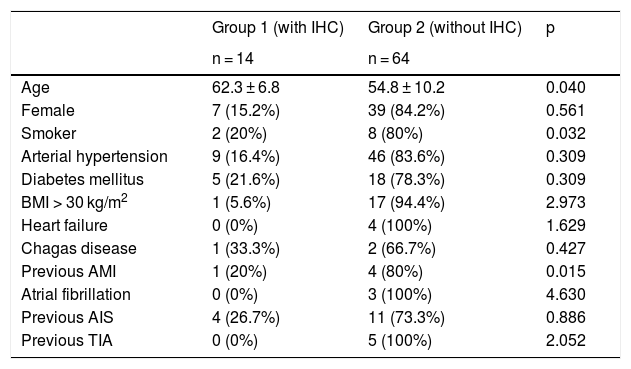Patients with stroke are at risk of developing non-neurological in-hospital complications (NNIHC) during hospitalization. The NIHSS is a scale used and validated to determine stroke severity, treatment, and prognosis. We evaluated the relationship between the NIHSS score obtained on admission and the development of NNIHC during hospital stay.
MethodsObservational study of prospective cohorts. Patients admitted consecutively for stroke, to an intermediate care ward, in Argentina between 08/01/2017 and 02/29/20 were included. The patients were divided into Group 1 (with NNIHC) and Group 2 (without NNIHC).
ResultsThe final n consisted of 78 individuals, 41% women. When comparing the means of the NIHSS score, differences were observed between the groups in the development of NNIHC in general (P = .050) and in the following specific complications: dysphagia (P = .014), aspiration pneumonia (P = .006), in-hospital pneumonia (P = .010) and intrahospital urinary infection (P = .004). The cut-off point of 10.5 presented the best predictive performance of NNIHC (AUC = .706; P = .016).
ConclusionsAn NIHSS value ≥10.5 was related to the development of NNIHC in patients admitted for stroke.
Los pacientes con ictus isquémico (II) presentan riesgo de desarrollar complicaciones intrahospitalarias no neurológicas (CIHNN) durante la internación. El NIHSS es una escala utilizada y validada para determinar gravedad, tratamiento y pronóstico del II. Evaluamos la relación entre el puntaje NIHSS obtenido al ingreso y el desarrollo CIHNN durante la estancia hospitalaria.
MétodosEstudio observacional, de cohortes prospectivas. Incluyó pacientes ingresados consecutivamente por II, en una sala de cuidados intermedios, entre 01/08/2017 y 29/02/20, en Argentina. Se dividió a los pacientes en Grupo 1 (con CIHNN) y Grupo 2 (sin CIHNN).
ResultadosLa n final constó de 78 individuos; 41% mujeres. Al comparar las medias de puntaje NIHSS, se observaron diferencias entre los grupos para desarrollo de CIHNN en general (p = 0,050) y para las siguientes complicaciones específicas: disfagia (p = 0,014), neumonía aspirativa (p = 0,006), neumonía intrahospitalaria (p = 0,010) e infección urinaria intrahospitalaria (p = 0,004). El punto de corte de 10,5 presentó el mejor desempeño predictivo de CIHNN (AUC = 0,706; p = 0,016).
ConclusionesUn valor de NIHSS ≥ 10,5 se relacionó al desarrollo de CIHNN en pacientes ingresados por II.









